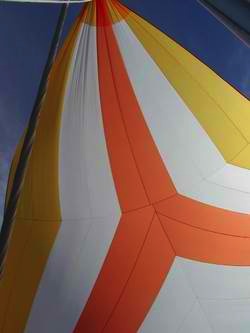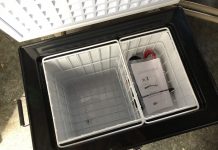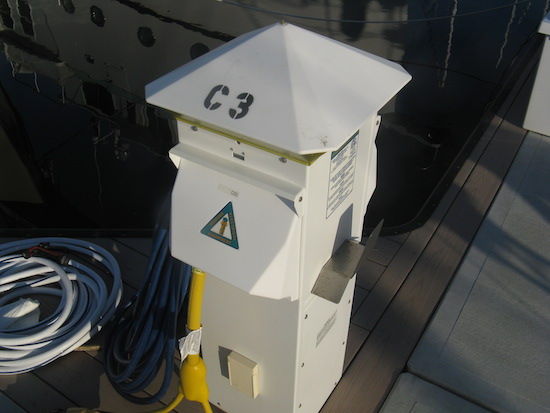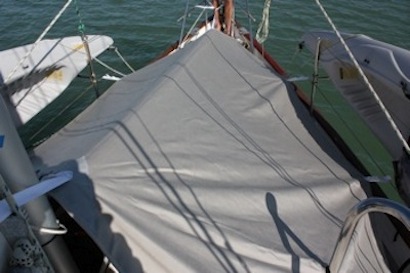The spinnaker came with the boat. It’s beautiful. It also takes up several square feet of space that we could allocate to something used more frequently.
BUT, when the wind is light and the wind is off the stern quarter (on a broad broad reach) … as the spinnaker unfurls and fills with wind and the boat dances along on the water, it’s almost as much as an “aaaahhhhh” moment as when the rumbling diesel shuts down and the wind fills the sails. We don’t use it nearly as much as we should, but when we do .. such as the run from Roatan to the Cayos Cochinos in the Bay Islands … for me, it’s pure magic. Plus it’s dominantly orange, which coincidentally is David’s favorite color.

Our spinnaker is a “cruising spinnaker”, which for us non-techie types means it doesn’t have to use a spinnaker pole., making it easier. Our step by step procedure – doesn’t mean this is the right way, or only way, it’s just our way.
Step 1: Attach the halyard to the top of the spinnaker.
Step 2: The tack, or front end, of the spinnaker attaches around our roller furling with a sleeve, making it a cinch to attach. Look closely at the base of the roller furling and you’ll see the way it loops around the roller furling. There’s also an attachment line that you can’t really see in the photo that attaches to the base to keep the slide from sliding up too far on the roller furling.

Step Three: Attach the spinnaker sheet to the clew (back side) and run the sheet back to the cockpit winches.
Our spinnaker came with an ATN sleeve which in our opinion, is an absolute necessity, especially if you’re sailing with just two aboard. It’s much easier to get up and down with an extra couple, but 98% of the time, it’s just us.
Step Four: Raise the sleeve to the top via the spinnaker halyard.
Step Five: Pull the line that raises the sleeve to the top.
MAGIC! The wind fills the spinnaker with a little poof and away we go!
Unfortunately, our spinnaker is only rated to 10 knots or so of wind, so it’s a light air sail. But I wouldn’t want all that sail area up if the wind was much more than that! Too difficult for us to manage with just the two of us.
Even though we use it sparingly, actually much more now than the six years we spent “out cruising”, although we used it in the Western Caribbean, there are a couple of memories that stick in my mind.
 The first was when we first bought the boat and took it out on the Chesapeake for our first anchored out weekend. We could not WAIT to put up the spinnaker. The wind was only about 8 knots, but when David grabbed the sheet and when the wind filled the spinnaker, he was dangling above the deck, about to to out over the water like we’ve seen on TV. He decided not to go there and dropped to the deck, letting go of the line. But the image of the split second he dangled there & the look on his face was priceless.
The first was when we first bought the boat and took it out on the Chesapeake for our first anchored out weekend. We could not WAIT to put up the spinnaker. The wind was only about 8 knots, but when David grabbed the sheet and when the wind filled the spinnaker, he was dangling above the deck, about to to out over the water like we’ve seen on TV. He decided not to go there and dropped to the deck, letting go of the line. But the image of the split second he dangled there & the look on his face was priceless.
The second memory was sailing down the coast of the Yucatan to Ambergris Cay, Belize (San Pedro). It’s a tricky reef entry and we were motorsailing overnight paralleling the reef a few miles out to make sure we didn’t accidentally stumble onto it during the dark. All of a sudden the diesel hiccupped and sputtered to an absolute halt. It was my watch, but it didn’t take David two seconds to bounce up from below. We tried restarting, but no luck. There was very little wind, but what there was was blowing us closer to the reef — YIKES! In our infinite wisdom (or maybe confusion?), we decided to put up the spinnaker to capture what air there was to keep us moving OUT and not closer. So I’m on deck alone, with a spinnaker that kept collapsing from not quite enough wind and trying to keep the boat moving away from the reef.
David’s down below, has the engine compartment dismantled and cleaning out everything he could. It was a case of bad diesel blocking the fuel filters & he had to change them more than once before the diesel caught and sputtered back to life for good.
We were able to make the reef entrance to Ambergris Caye to check into Belize safely, but we were worried for a few hours. Why is it things like this happen when you’ve had no sleep? 🙂 It was our first experience with bad fuel clogging the filters – we have a fuel polishing system (essentially extra Racor filters that filter the fuel and can transfer it back and forth between the two tanks) and the fuel polishing is usually enough. For more on our fuel saga – one that’s accentuated by being commuter cruisers – wait for Friday’s post!
So our spinnaker will remain on board and continue to take up space, but every time it’s blocking my way to get to something else, I remember the good times and the lighthearted feeling when it goes poof.
I know alot of boats prefer the space to the spinnaker, so feel free to leave comments or add information that might help others! Cheers! Jan















I understand your conundrum. This summer we left it off the boat for a hundred mile trip and had to motor downwind, there and back… Had we brought it we would have had a two wonderful sails. So we put it back on the boat and haven’t had the occasion to use it since. Keep it aboard. It’s like having a specialized tool you rarely need, but when you need it there’s no efficient substitute.
Good way to think of it Larry! Thanks! Cheers — Jan
When you pull the sleeve up and the wind fills and that big beautiful sail “whoomps” you’ll make the room to keep it. We do!
Martin — I could not agree more! Almost as good as the minute the diesel rumbles to a halt and all we hear is the water swishing past the hull and the wind in the rig. Aaaahhhhh!!! 🙂
Cheers — Jan
We’ve asked this question as well. My husband LOVES to fly the spinnaker. I’m a bit nervous about it and, like you, we will ONLY fly it if the winds are REALLY light with just us two. We are taking ours with us. We can always lose it later if we end up never using it. Good to hear that at least ONE other cruising boat is using theirs.
We use ours. Not very often though. It’s under the forward berth mattress which is under all of our daily use crap. A pain, but Mark loves to fly it!
The lesson I learned is – for cruisers, planning for downwind sailing is much more important than upwind. I should have invested in my whisker pole much sooner (higher priority than the spinnaker). There are more situations where the pole is used with my genoa, rather than the spinnaker. But, we now have both and use them as conditions dictate.
Jan, this is perfect timing! As you know, I posted this question on FB today … we both must have had spinnakers on the brain! =)
Would love to keep ours onboard but … wouldn’t doubt if it’s left behind. Our Catalina 30 is roomy, but doesn’t have much storage space…
Personally I regard our asymmetric as an essential piece of safety kit. Whilst it might see the light (and what a joy) just occasionally, there are times when it could literally be a life saver. Like last summer crossing a busy shipping lane with barely any wind and a broken engine…